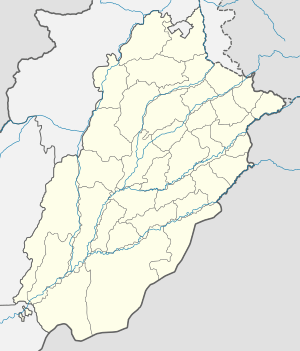Kamoke
Kamoke (Punjabi: کامونکى, Urdu: کامونکے) is a city in Gujranwala District, Punjab, Pakistan. It is the 30th largest city of Pakistan. The city is the capital of Kamoke Tehsil, which is an administrative subdivision of the district and is itself subdivided into 8 Union Councils.[3] It is located on the Grand Trunk Road 21 km from Gujranwala and 44 km from Lahore.
Kamoke کامونکی | |
|---|---|
City | |
| کامونکے | |
 Municipal Committee logo | |
| Nickname(s): The City of Rice & The City of Mosques | |
 Kamoke Location in Pakistan  Kamoke Kamoke (Pakistan) | |
| Coordinates: 31°58′25″N 74°13′22″E | |
| Country | Pakistan |
| Region | Punjab |
| District | Gujranwala District |
| Tehsil | Kamoke Tehsil |
| Government | |
| • Type | Municipal Committee |
| • Chairman | Rana Sajjad Ahmed Khan |
| • Vice Chairman | Muhammad Younas |
| • Chief Officer | Muhammad Aslam Ghuman |
| Elevation | 201 m (659 ft) |
| Population | |
| • Total | 249,767 |
| • Rank | 30th, Pakistan |
| Time zone | UTC+5 (PST) |
| Area code(s) | 055 |
| Website | MC Kamoke |
History
Kamoke city was settled in the era of Akbar. It was declared a tehsil in 1992.
Administration
Kamonki is administered by Town Municipal Administration under City District Government Gujranwala. It has Tehsil Civil Courts, its own circle of police, and a tehsil headquarters hospital.
Communication
Kamoke is situated at the Grand Trunk (G.T.) Road, about 49 Kilometer in the North from Lahore. It is almost at equal distances from Allama Iqbal International Airport Lahore and Sialkot International Airport. Kamoki is also located at the main Lahore Rawalpindi Railway Line.
Trade and Industry
Kamoke is known for its rice, which are grown in its surrounding areas. Kamoke is also the largest rice market in the sub-continent where almost all kinds of rice, which include, Basmati, Super Basmati, Karnal etc. are grown, processed and exported to the whole world.
Demographics
The population was 152,288 in 1998. The 2017 census shows a population of 249,767, an average annual growth of 2.6% since 1998, slightly above the national average of 2.4%.[4]
References
- "MC Kamoke: Administrative Setup". Local Government Punjab. Retrieved 2018-04-27.
- http://www.citypopulation.de/Pakistan-100T.html
- Towns & Unions in the City District of Gujranwala - Government of Pakistan Archived 2012-02-09 at the Wayback Machine
- "Pakistan: Provinces and Major Cities - Population Statistics, Maps, Charts, Weather and Web Information". www.citypopulation.de. Retrieved 2019-02-15.